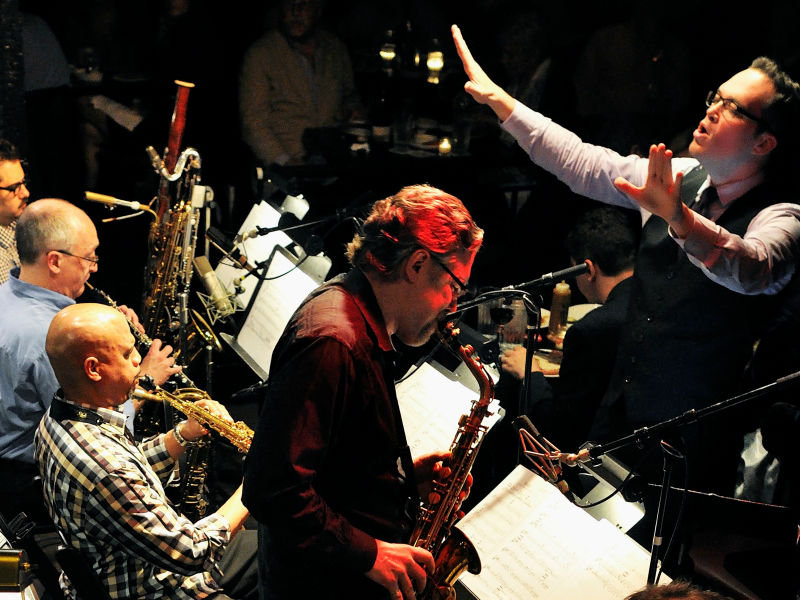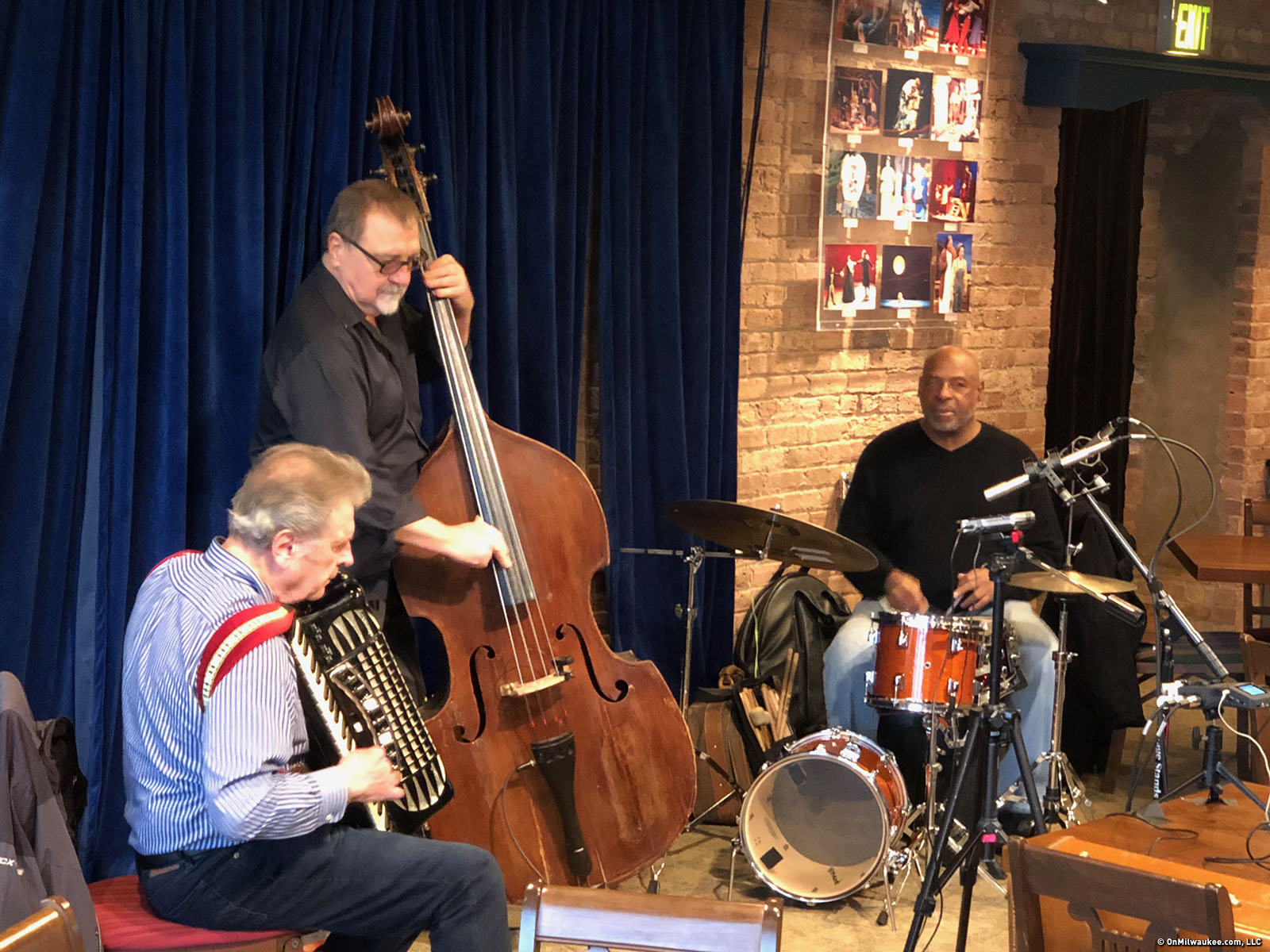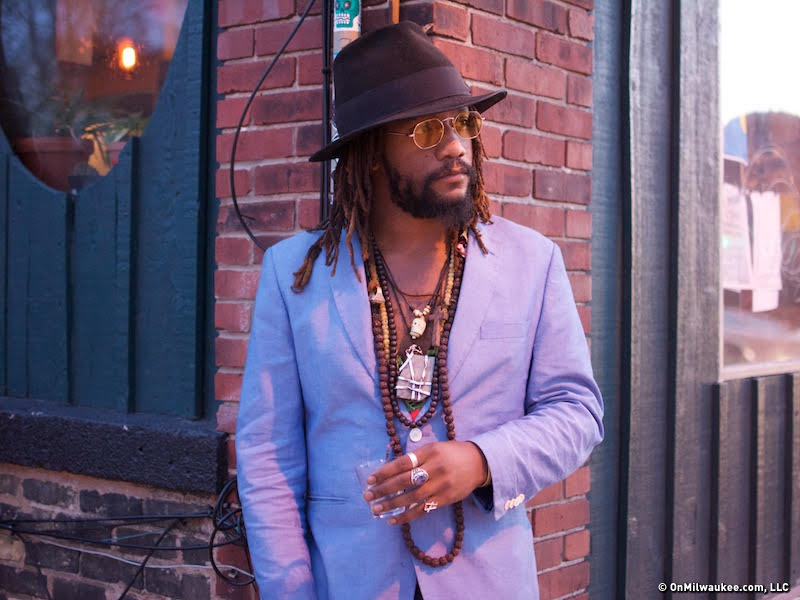All the brass horns gleam, whisper and shout. Tonal colors multiply, merge and melt, without digital trickery. Today’s jazz orchestra composer-arranger’s pen conjurs sumptuous landscapes for the soloist’s ramble. Impressive recordings of them proliferate lately, some winning best-of-the-year polls and wide acclaim.
But aren’t big bands a creaking dinosaur of the swing era? Something is afoot, a reborn beast with a huge sonic footprint.
The creature may herald a new golden age of the jazz orchestra. Consider, the most expansive jazz form remains historically important and globally influential.
Two of the best last two rock concerts I attended both included a horn section: Gregg Allman's band in Milwaukee and the 11-piece Tedeschi Trucks Band in Madison, a jazzy blues-rock group that many critics – including myself – consider the best band in popular music today. Lyle Lovett’s Large Band (essentially a jazz orchestra) has revitalized that country singer-songwriter’s career.
Then pop superstar Lady Gaga recorded with timeless Tony Bennett, their acclaimed hit album "Cheek to Cheek" impressing even picky jazz critics with a repertoire from the first golden age of big bands. They're also touring with a full jazz orchestra, with two dates at Ravinia Festival in Highland Park coming on Friday, June 26 and Saturday, June 27.
As far as Milwaukee big band music goes, The All-Star SUPERband has played weekly throughout the 21st century on an almost steady basis, performing a challenging and diverse repertoire. They will play a benefit concert at 5 p.m. on Wednesday, June 24 at the Briggs & Stratton Big Backyard at the Zoo Terrace for Easter Seals of Southeastern Wisconsin, preceding the charity’s annual Walk With Me fund raiser at the Milwaukee County Zoo.
Led by bassist Gary Christensen, the band highlights renowned saxophonist-flutist Warren Weigratz, widely-traveled alto saxist-clarinetist Tim Bell, trumpeter Kaye Berigan (whose uncle Bunny starred in the first golden age) and other top-flight area pros who relish the band’s power and palette. The SUPERband’s cover charge every week goes to charitable benefits. This is high-calorie music played for the love of it, and it shouldn’t be missed.
To the west, The Madison Jazz Orchestra, formed in 1986, performs monthly and with comparable ambitious quality to Milwaukee’s big band. A "battle of the bands" between these Milwaukee and Madison orchestras would be epic.
Also, The Large Unit, an avant-garde nonet of European musicians, will also perform Wednesday, June 24 at 8 p.m. in Milwaukee at Sugar Maple, 441 E. Lincoln Ave., as part of the annual Okka Fest.
A critical measure of the golden age of any medium is the level and range of artistry at work among a wide array of serious practitioners, without obvious commercial hooks. Still, I’m defining jazz orchestra broadly (see discography) to include rock- or blues-oriented groups with at least three horn players who improvise to show the large form’s ongoing influence.
Two auspicious and related examples of full jazz orchestras with brand-new recordings are "The Thompson Fields" by the Maria Schneider Orchestra and "Lines of Color" by The Gil Evans Project – formed and led by Verona native Ryan Truesdell. Truesdell also produced "Sky Blue," Schneider’s previous Grammy-winning orchestra album. The orchestras share a handful of musicians. Meanwhile, last year’s most conceptually ambitious – if not best – jazz recording was "Identities are Changeable" by Miguel Zenon and his "Identities" Big Band.
But the Evans influence seems ascendant – in Schneider, Truesdell and the brilliant Canadian composer-orchestra leader Christine Jensen, among others. The primary influence of Schneider, the premier orchestra leader in jazz today, is Evans, the impressionistic sorcerer who conjured palpably evocative backdrops for Miles Davis’ classic albums "Miles Ahead," "Porgy and Bess" and "Sketches of Spain." In fact, Schneider served as Evans’ musical assistant for three years before his death in 1988.
Equally taken by Evans, Truesdell befriended the late bandleader’s family, who eventually allowed him to investigate Evans’ unpublished, unrecorded scores. The first result was the sensational Gil Evans Project album "Centennial: Newly Discovered Works by Gil Evans," arguably the jazz event of 2012. Now comes "Lines of Color," a vibrant, witty, swinging live-at-the-Jazz Standard follow-up.
Numerous recent orchestra recordings defy the worst economic catastrophe since the Great Depression, not to mention jazz’s small presence in corporate-controlled, bottom-line radio and music industries. Try maintaining a 16-to-18 musician ensemble that requires extensive rehearsal, a collective response to one leader’s creative whim and will, in an art dominated by the "rugged-individual" instrumentalist.
"Shocking" is what Truesdell calls all the recording and activity.
"But people are getting grant money and finding ways," he said in a phone interview. "And it is so much cheaper to make a recording now. You can you record them on your own. Or they do live recordings which are so much easier to do. There is a cost-effective ways of making a big-band work.
"I don’t know if it’s a new golden age, but people are trying to do something different. Everybody’s got a quartet or trio, so people are searching for something kind of different and some musicians think their voice will be different if they go larger."
Gil Evans, extending Duke Ellington’s innovations, actually opened the door in the late '50s for a modern jazz orchestra concept. That continued in ensembles led by Thad Jones and Mel Lewis, Oliver Nelson, Gary McFarland, Gerald Wilson, Chico O’ Farrell and Toshiko Akiyoshi. Composer-arranger Claus Ogerman’s 1989 collaboration with Miles Davis, "Aura," reimagined the trumpeter’s glory days with Evans. This all persisted despite the peaks and valleys of jazz popularity. However, jazz fusion spawned a period where big bands and brass-heavy rock bands embraced electricity and rock beats, including The Don Ellis Orchestra; The Buddy Rich Big Band; Woody Herman with star blues-rock guitarist Michael Bloomfield; Blood, Sweat, and Tears; Bloomfield’s Electric Flag, and the most commercially successful, Chicago.
Nevertheless, today most jazz orchestras use the pure acoustic power, color and range inherent to a sonic palette that Gil Evans expanded by employing all the wind instruments of a classical music orchestra, in ingenious voicings and settings.
"I think it’s a combination of people for whom the jazz orchestra is their voice, and of leaders in small ensembles finding their voices in larger ensembles," Truesdell says. "And how they’re doing it, I guess they don’t pay people very much, just like everybody else," he laughs. He adds that all the recording groups aren’t touring nearly as much as big bands did in the swing era.
Among other important current recorded ensembles are The Clayton-Hamilton Orchestra, the Vanguard Orchestra, Darcy James Argue’s Secret Society, The SFJazz Collective, The Christine Jensen Jazz Orchestra, The John Hollenbeck Large Ensemble, "Quiet Pride: The Elizabeth Catlett Project" led by Rufus Reid, The Chris Potter Underground Orchestra, The Archie Shepp Attica Blues Orchestra, and 2015 Grammy album winners, Arturo O’Farrell and the Latin Jazz Orchestra for "The Offense of the Drum" and Gordon Goodwin’s Big Phat Band for "Life in the Bubble."
Composer-arrangers like Quincy Jones – best known for work with Michael Jackson and Miles Davis – and Vince Mendoza freelance with numerous jazz and symphony orchestras. Mendoza’s widest exposure came with his sumptuously simpatico enhancements of Joni Mitchell on her double Grammy-winning "standards" album "Both Sides Now," including a Grammy for Best Instrumental Arrangement Accompanying a Vocalist.
Another excellent recent recording was "Fly!" by The Mitch Shiner Big Band, led by a graduate of Mequon High School. Last winter, Milwaukee saw The Jazz at Lincoln Center Orchestra led by composer-trumpeter Wynton Marsalis in a superlative holiday concert featuring today’s hottest jazz singer, Cecile McLorin Salvant.
Perhaps the seeds for a new golden age of orchestra were sown in 1997 when Marsalis and his orchestra bested all "legit" composers for the Pulitzer for Best Musical Composition, for the soulfully solemn orchestral oratorio "Blood on the Fields." It has spurred other ambitious jazz orchestral inquiries into African-America history.
Many classic big bands from the swing era still remain intact and tour under new leadership. Milwaukee just heard The Woody Herman Orchestra recently at UWM for Jazz Appreciation Month in April. Herman, famous for his always forward-thinking Thundering Herd, was a Milwaukee native.
Speaking of universities, the persistence of the jazz orchestra goes back to education. Despite the ever-present lure of small-combo guitar rock-pop, countless young musicians dedicate themselves to orchestra instruments and to rigorous, competitive high school and college ensemble programs, as a cursory survey of Down Beat magazine’s large annual education section proves.
"There are 2,318 rehearsal big bands on the planet," asserts Gary Christensen, leader of the All-Star SUPERband. "On YouTube, I came across a young people’s big band in Japan really nailing this high-level jazz piece. So it’s like, wow, they really are everywhere!"
The UWM Jazz Ensemble and The Marquette University Jazz Band, of varying sizes, function alongside the school’s traditional classical music instruction. Most jazz orchestras require strong reading ability of sometimes devilishly complex charts, the disciplined ear for harmonizing, counterpoint and tricky time signatures, as well as individual imagination and virtuosity for soloing.
A gifted composer-arranger like Schneider, Marsalis, Argue or Jensen – or the SFJazz Collective’s multiple composer-arrangers, including the brilliant Miguel Zenon – can make musical magic with such forces. And that magic, one that transports the imagination and spirit, never goes out of style.
To check out Kevin's discography, tracking the recorded development of modern jazz orchestra, click here.







